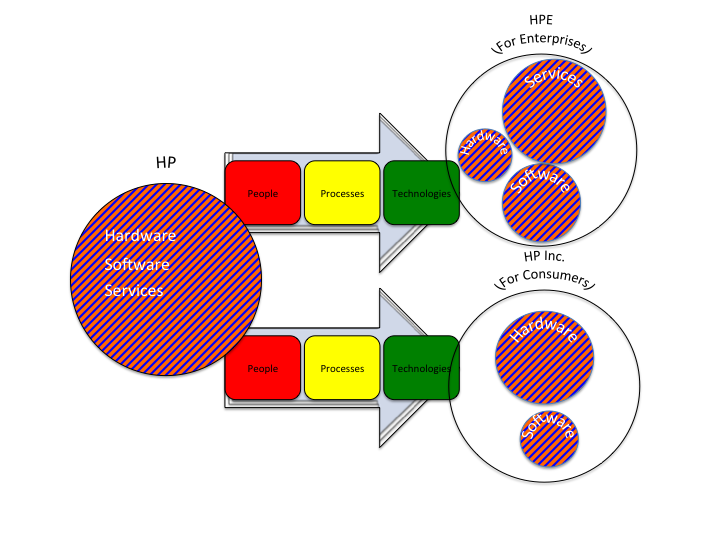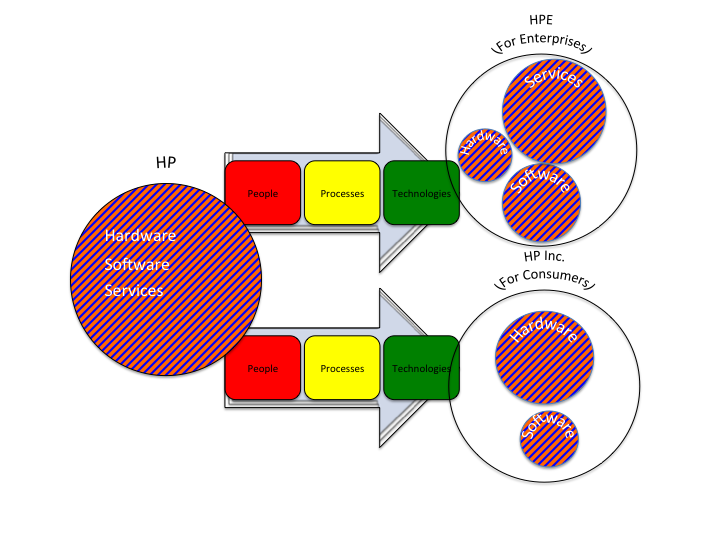A year ago Hewlett Packard (HP) decided that it was going to split into two companies. This decision became real last week when HP officially split into HP Inc. and Hewlett Packard Enterprise (HPE) as announced by Meg Whitman on her LinkedIn post. The main reason given for this split was the focus. HP Inc. would focus on selling consumer products such as personal computers and printers. HPE would focus on selling enterprise products, enterprise software and enterprise services such as cloud computing, big data, cybersecurity to improve operations.
It seems that on the surface the announcement of the split of HP into HP Inc. and HPE has received a mixed bag of optimism and skepticism from different corners of the tech industry. On the optimistic side, this is a good move since it would help these companies focus on their core competencies and provide focused customer service and client experience. On the skeptical side, this is a little too late since the tech industry has been moving from merely selling computer products to selling more technology software and services for at least 20 years.
If we observe the tech industry from a modern economics lens we would find that this split is not something that is novel but it is very predictable. From a modern economics lens, the ‘primary sector’ for the tech industry focused on hardware and products, the ‘secondary sector’ for the tech industry focused on software and the ‘tertiary sector’ for the tech industry focuses on technology services. What is interesting is that this split lets HP Inc. focus on the ‘primary tech sector’ for consumers while HPE focuses on both the ‘secondary tech sector’ and the ‘tertiary tech sector’ simultaneously for enterprises. Eventually, though, HPE would increase its focus on the ‘tertiary tech sector’ since the margins are much better in services as compared to just products and software. In order for HPE to become a bigger player in the services market, they should consider the following:
|
Currently |
In the Future |
| Who is leading the services division?
| Who should be leading the services division? |
| What processes are being followed to provide services? | What processes should be followed to provide services? |
| Where the mix of tech and non-tech services are being provided? | Where a mix of tech and non-tech services should be provided? |
| When are services bundled with hardware and software? | When should services be bundled with hardware and software? |
| Why standalone services are provided? | Why should standalone services be provided? |
HPE leadership has to realize that any organizational splits are not without consequences. These consequences could entail: (1) Stocks becoming more volatile as any budget cuts with client enterprises could affect the bottom line, (2) Competitors might be able to provide the same level of service at a cheaper cost with better client experiences and (3) Lack of optimized processes with no flexibility to adjust for enterprise clients needs could reduce overall reputation of HPE.
One of the ways to address the above-mentioned split issues would be to create independent mock enterprise client teams that would rate how easy or difficult it was to deal with HPE in light of changing economic conditions, client experiences and efficient and effective processes. These independent mock enterprise client teams would be used to further refine HPE and put itself in the shoes of its enterprise clients.



You must be logged in to post a comment.